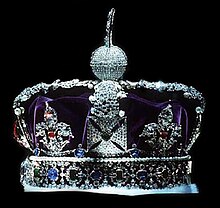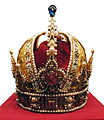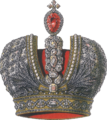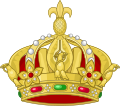皇冠

皇冠(英語:imperial crown)是包括皇帝在内等拥有帝号的君主于加冕礼等场合下穿戴的一种冠冕。
设计[编辑]
中世纪时代的欧洲冠冕在设计和风格上各有不同:
An open crown is one which consists basically of a golden circlet elaborately worked and decorated with precious stones or enamels. ... The medieval French crown was of this type. ... the closed crown, which had bands of metal crossing usually from one side to the other and from back to front so that they met in the middle, at the top of the head. ... These arches are in part utilitarian, since they serve to strengthen the crown, in part decorative, since they are normally made to serve as supports for a central cross or jewel, and in part traditional, since a contributing element to the evolution of many medieval crowns was the structure of the early Germanic helmet, which had metal bands crossing at the top of the head to protect the skull from injury.
A special case of a closed crown was that of the Holy Roman Empire. This was originally an open crown, made up of eight separate richly jewelled sections incorporating four magnificent enamelled plaques, but the Emperor Conrad II (1024–39) had added to it a kind of jewelled crest, running from front to back, to which he had thoughtfully attached his name, CHVONRADVS DEI GRATIA ROMANORV(M) IMPERATOR AVG(VSTVS). This jewelled crest was so closely associated with the notion of the imperial office that when the Habsburgs made a new imperial crown in the 15th century in which they incorporated two large cusps resembling a mitre seen sideways, they provided it with a similar crest running from front to back and topped with a central jewel. ... Strictly speaking, therefore, the only type of crown whose characteristics can properly be regarded as imperial was one with a single crest running from front to back. In practice, in countries unfamiliar with closed crowns at all, any kind of closed crown was assumed to be imperial in character.
——Philip Grierson[1]
During the Middle Ages the crowns worn by English kings had been described as both closed (or arched) and open designs. This was in contrast with kings of France who always wore an open crown. However, there is academic debate on how often closed crowns were used in England during this period, as the first unequivocal use of the closed crown was by Henry IV of England at his coronation on 13 October 1399.[2][3] However his effigy on his tomb in Canterbury Cathedral wears an open crown, so the link in England between the style of the crown and its representation as that worn by a king and an emperor was not established.[3] The use of a closed crown may have been adopted by the English as a way of distinguishing the English crown from the French crown,[4] but it also had other meanings to some. For example, Henry V of England wore a helmet-crown of the arched type at the Battle of Agincourt which the French knight St. Remy commented was "like the imperial crown".[5]
The association of the closed crown with imperial crowns was already established in Continental Europe by the late 14th century, for example the florins minted for Charles IV, Holy Roman Emperor) sometimes show him with a closed crown (though on the commoner variety, the crown is open). A miniature picture in the Chronica Aulae Regiae written in the great abbey outside Prague depicts his mother Elizabeth, a queen of Bohemia, wearing an open crown, while his two wives, who had imperial titles, have closed ones.[6]
During the machinations that surrounded the introduction of the imperial crown under Henry VIII (see the section below Legal usage), the closed crown, became associated as a symbolic representation of the English Crown as an imperial crown,[7][a][b] and has remained so until this day.[10]
各式皇冠[编辑]
罗马帝国皇冠[编辑]
拜占庭帝国皇冠[编辑]
-
查士丁尼一世皇帝头戴“stemma”皇冠的形象
-
君士坦丁九世的皇冠
附有主教冠的皇冠[编辑]

带有单拱以及可展开式主教冠的皇冠[编辑]
-
查理曼大帝圣髑盒头上的皇冠
带有单拱以及固定式主教冠形状的皇冠[编辑]
具有高拱形状的皇冠[编辑]
奥斯曼帝国皇冠[编辑]
-
苏莱曼大帝的威尼斯头盔(可能已毁)
普鲁士-德国皇冠[编辑]
-
德意志国冠,木制模型,1872年
-
皇后冠冕
拿破仑皇冠[编辑]
-
名为“查理曼之冠”的拿破仑皇冠
-
头戴桂冠的拿破仑一世(该冠于1819年被毁)
其他基于欧洲式冠冕设计的皇冠[编辑]
-
Empress Ana Maria of Mexico with the Crown of the First Mexican Empire
-
Brazilian Imperial Crown of Pedro I
-
Design of the Imperial Crown of Mexico seen in paintings of Maximilian I of Mexico during the Second Mexican Empire
-
Imperial Crown of the Central African Empire — the Imperial Crown worn by Emperor Bokassa I at his coronation in 1977.
其他非欧洲式冠冕设计的皇冠[编辑]
-
Kiani Crown, Imperial Crown in Persia
-
Consort Crown of Persia
-
Ming Dynasty Emperor Imperial Crown for full ceremonial dress
-
明定陵中出土的金丝翼善冠
-
Ming Dynasty Empress Phoenix Crown
-
Kangxi Emperor of Qing Dynasty wearing Imperial Crown
-
祭祀冠服Imperial Crown of the Empire of China — worn by Yuan Shikai when he proclaimed himself emperor in 1915.
-
Imperial Crown of the Japanese Emperor, Edo-Period
-
Vietnamese Nguyen dynasty Imperial Crown
-
Imperial Ethiopian crown
参见[编辑]
参考文献[编辑]
- ^ Henry changed his coinage and his Great Seal from depicting himself with an open crown to a closed one to depict the imperial nature of the English Crown.[8]
- ^ Shortly before Henry VIII of England started his breach with the Roman Catholic Church, Maximilian I, Holy Roman Emperor, as regent for his son Philip the Handsome, had the real d'or coin struck depicting a closed crown, which due to the close trading links between the Low Countries and England would have made the imagery familiar to English men involved in trade and this may have influenced Henry's choice of a difference style of crown.[9]
- ^ Grierson 1964,第127–128頁.
- ^ Chris Given-Wilson, Henry IV (New Haven: Yale University Press, 2016), pp. 151-52.
- ^ 3.0 3.1 Grierson 1964,第129頁.
- ^ Grierson 1964,第129, 133頁.
- ^ Grierson 1964,第130頁.
- ^ Grierson 1964,第130 footnote 3頁.
- ^ Grierson 1964,第118, 130–131頁.
- ^ Grierson 1964,第131頁.
- ^ Grierson 1964,第118, 134頁.
- ^ Grierson 1964,第132頁.
外部链接[编辑]
- Grierson, Philip, The origins of the English sovereign and the sybolism of the closed crown (PDF), British Numismatic Society, 28 January 1964 [2023-10-19], (原始内容存档 (PDF)于2022-10-13)
| ||||||||||||||||||||||||










































